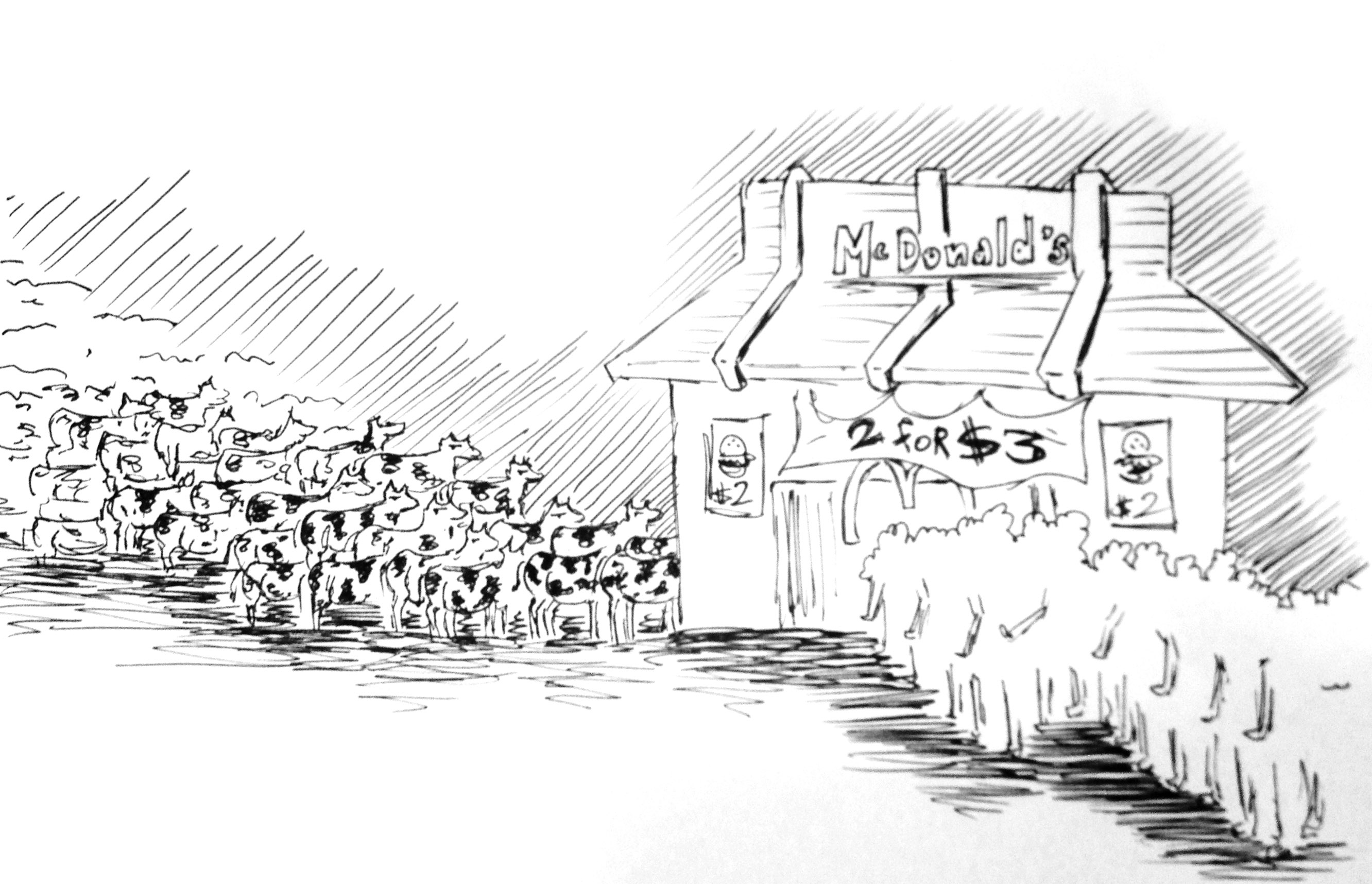Cinema Politica Concordia kicked off its 2014-15 season with Cowspiracy: The Sustainability Secret, a hard-hitting film on environmental destruction that markets itself as the new An Inconvenient Truth. Co-directed by narrator and researcher Kip Andersen and videographer Keegan Kuhn, it presents the primary cause of environmental deterioration: cows. More specifically, it cites the production of commercial livestock and society’s ever-present need for increased meat and dairy production as the culprits, not to mention corporate greed, willful political blindness, and the environmenal activism groups that are witholding these truths. While the documentary is convincing in its presentation and heartfelt in its message, Cowspiracy comes off as a series of strong convictions and half-baked answers.
The film starts with a general biography of Andersen, who was inspired by the horrors of An Inconvenient Truth to become an environmental filmmaker himself. Now a strict vegan and a self-proclaimed “obsessive recycler,” Andersen tells the story of his realization that changing his individual lifestyle was not enough. In his search to discover a way to make an actual impact on the environment, Andersen began to look for the root cause of all the problems he sought to fix. After extensive research, he arrived at the conclusion that the true cause of most of the planet’s destruction comes directly from the practice of animal agriculture – in other words, the practice of raising (and in most cases slaughtering) livestock for edible products such as meat and dairy.
With eye-opening statistics –for example, animal agriculture accounts for fifty one percent of greenhouse gases – and numerous interviews with scientists, disgruntled ex-farmers, and representatives of the top environmental activist organizations, Andersen cements his argument. In the end, there is a sincere plea to switch to a vegan diet as it requires less land, produces less waste, and could potentially rebalance our planet’s ecosystem.
Anderson manages to present the sheer size of the consumptive waste that is created by and for livestock with both gravity and subtle wit. The film’s facts are shocking and provoke the viewer to contemplate the severity of our planet’s environmental degradation. Cowspiracy emphasizes the seriousness of a siuation where not only is the government not paying attention, but the organizations who claim to be working to solve these environmental issues either do not know their actual cause or choose not to share it with the public.
Andersen also adds a personal edge to the film by portraying how environmental activists such as himself have suffered for their research, citing the repression and murder of green-minded activists in Brazil, and the closer to home case of Cowspiracy losing its financial backing due to the film’s potential for controversy. Instead of coming off as overly dramatic, this angle supports and propels Andersen’s message beyond mere contemplation.
However, the film does not focus on much more than these cold facts. Whether the absence of proposals toward an environmental solution is intentional or not, it is undoubtedly where the film’s faults arise and where questions go answered. Don’t be mistaken, the film does devote some time toward showing the alternatives to meat and dairy eating; for example, the production of equally-nutritious, plant-based “meat,” “yogurt,” and “eggs,” or community farms that grow plants and vegetables. Andersen also devotes time to explaining the dietary reasons for a vegan lifestyle. But whether these are viable options already in production or in the growing stages of development is not made clear. Additionally, the film does not address the development cycle for these kinds of products – whether they produce waste as well. In a question-and-answer session after the film, Andersen claimed that “roughly 98 per cent of people have access to vegetables,” without acknowledging that meat alternatives are often more expensive than fast food, and thus inaccessible for large portions of the population. The absolute lack of acknowledgement of any kind of complications that could occur with the shift toward veganism (both as a diet and means of using land) makes the proposed solution come across as a godsend rather than a viable option in the eyes of a discerning viewer.
Andersen also hinders his own argument with a clear personal disdain for meat eaters. Given the circumstances of the film, this bias is understandable. However, for the uninformed it ignores a diversity of upbringings, traditions, beliefs, and financial situations. At one point in the question-and-answer session, Andersen went so far as to call meat eating “an addiction to animal flesh and animal secretions.” With this kind of mentality it will be hard to foster a discourse with meat-eaters, let alone catalyze a worldwide dietary change – the movie ends up translating as more of a guilt trip than an impetus for change.
While the film presents its ideas with an impressive fervour toward respecting the lives of animals, inspiration does not successfully cover for the lack of information on the practicalities of ending animal agriculture. This gives the idea of living as a vegan an idealistic appeal but ultimately less credibility. Due to these limitations, Cowspiracy: The Sustainability Secret is unlikely to cause an agriculture revolution. That said, it certainly provides some good food for thought.
Cowspiracy: The Sustainability Secret will be available for DVD purchase and digital download November 6, and is currently available for preorder.

